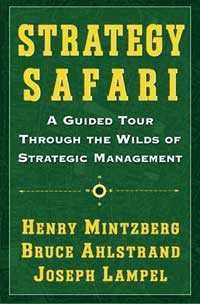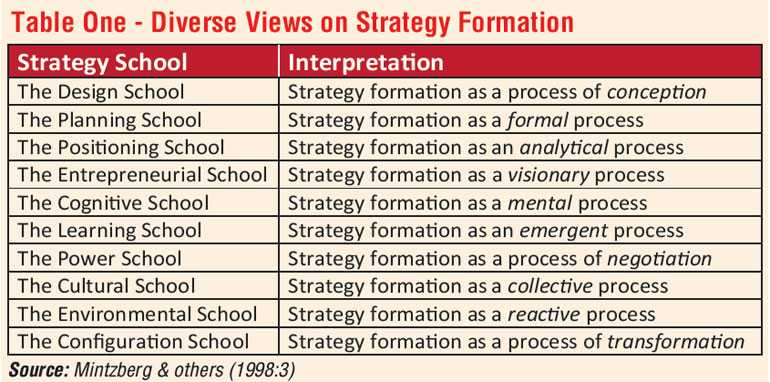Sunday Dec 15, 2024
Sunday Dec 15, 2024
Monday, 1 July 2019 00:00 - - {{hitsCtrl.values.hits}}
‘Strategy Safari’ by Henri Mintzberg and others is a book that I keenly read a couple of times. Every time I read it, new insights with fresh perspectives were quite common. As a book, it’s a bit old but still gold. I referred to it recently to seek clarity with regard to the way forward of Sri Lanka in the wake of the Easter Sunday tragedy. Today’s column is a reflection on the salience of ‘Strategy Safari’ with its associated lessons for Lankans.

Overview
Strategy is an often confusingly-used term that may mean different things to different people. I have seen this happening in Sri Lanka, where crafting and executing strategy is cluttered by myriad jargons. We need clarity and commitment towards formulating and implementing strategy at corporate level as well as country level. It is people who design and deliver in driving results. To recover the economic growth through a multi-sectoral approach with professionalism in action is a timely need for Sri Lanka.
Enter the ‘Strategy Beast’
“It seems that we are over-led and under-managed”, says Mintzberg. Many may disagree. Yet, you cannot undermine this candid Canadian veteran. Having contributed to management in proposing 10 key managerial roles way back in 1971, he is sharp and sensible in his criticism.
Mintzberg cites a poem written by John Godfrey Saxe (1816-1887) highlighting the possible confusions towards strategy.
It was six men of Indostan
To learning much inclined,
Who went to see the Elephant
(Though all of them were blind)
That each by observation Might satisfy his mind.
In essence, each of the blind men interpreted the elephant based on the part each one touched. The one who touch the tail thought that the ‘elephant is like a rope’.
And so these men of Indostan
Disputed loud and long,
Each of his own opinion
Exceeding stiff and strong,
Though each was partly in the right,
And all were in the wrong!
“We are the blind people and strategy formation is our elephant”, says Mintzberg. “One has grabbed hold of some part or other and “railed on in utter ignorance” about the rest. We certainly do not get an elephant by adding up its parts. An elephant is more than that. Yet to comprehend the whole we also need to understand the parts.”
It is obvious that being strategic is of utmost importance in the business context. It essentially shows how ‘smart’ you are in ‘playing the game’. The roots are from the Greek word ‘strategios’, which means the art of the General. Obviously, it has a military connotation. How a general orders the troops to attack, or to withdraw or to surround the enemy, with the aim of winning the war in mind. A battle front and a business front have a lot in common, particularly with the sky-rocketing competition, globally as well as locally.
Interestingly, Mintzberg and his co-authors have attempted to draw a parallel to six blind men to 10 different approaches to strategy. According to them, none of them is absolutely right or wrong, but each lacks the holistic perspective. Table one captures the essence of such 10 schools of thought.
The table one amply shows the diversity in the approaches with inevitable strengths and shortcomings. They all speak of strategy either as a ‘plan’, ‘pattern’, ‘position’, ‘perspective’ or a ‘ploy’. Interestingly, though not popular, Five Ps of strategy can be identified in this sense.
Do we see the presence of the above approaches in Sri Lanka? In both private and public sectors alike, a strategic plan or a corporate plan (both are interchangeably used to mean the same thing) is considered essential. A multi-coloured spiral-bound thick report is prepared and presented and perhaps that is the end of the story. Whether there is a serious emphasis on achieving the formulated plan is questionable. This is more prevalent in the public sector where the annual audits would check the availability of a strategic plan as a checklist item and the implications beyond them is hardly investigated.
Broad consensus on strategy
While there is great diversity in discovering the ‘strategy beast’, there is some consensus as well. Mintzberg presents them as areas of agreement.
1. Strategy concerns both organisation and environment. “A basic premise of thinking about strategy concerns the inseparability of organisation and environment. … The organisation uses strategy to deal with changing environments.”
Easter Sunday attack as an environmental factor for tourism in Sri Lanka is a bitter and fitting example for the above. The prompt response as an industry in the aftermath of such a disaster is indeed encouraging, yet a slow recovery is the painful reality.
2. The substance of strategy is complex. “Because change brings novel combinations of circumstances to the organisation, the substance of strategy remains unstructured, unprogrammed, nonroutine, and nonrepetitive….” 
In the VUCA (Volatile, Uncertain, Complex and Ambiguous) world that has come to our doorstep, the complexity of strategy is evident. The struggling Sri Lankan economy with global complications such as escalation of trade disputes, an abrupt tightening of global financial conditions, and intensifying climate risks could further find difficult to reach expected growth targets.
3. Strategy affects overall welfare of the organization. “… Strategic decisions … are considered important enough to affect the overall welfare of the organization….”
This highlights the need for the involvement of all stakeholders including employees. “The only route to improved performance is by placing human resource at the centre of your strategic decision-making”, argues Linda Gratton, in her much-acclaimed book, ‘Living Strategy’. Needless to say, that the strategies at national level should be formulated in line with a broad, inclusive and comprehensive manner.
4. Strategy involves issues of both content and process. “… The study of strategy includes both the actions taken, or the content of strategy, and the processes by which actions are decided and implemented.”
This is another aspect where we pay over-emphasis on content and less on process. Occurrence of grand events to launch programs at an enormous cost and the process of executing is grossly neglected is a regular feature in Sri Lanka. We see more inauguration ceremonies then opening events showcasing the pomp and pageantry.
5. Strategies are not purely deliberate. “Theorists … agree that intended, emergent, and realized strategies may differ from one another.”
This is very relevant to Sri Lanka where the strategies deliberated prior to the Easter Sunday tragedy have to be revisited. The dismal first quarter performance experienced by many private sector organisations have learnt it in a bitter way. Promoting local tourism with more attractive corporate packages can be one such emergent strategy until the foreign tourism arrivals improve to a satisfactory manner.
6. Strategies exist on different levels. “… Firms have … corporate strategy (What businesses shall we be in?) and business strategy (How shall we compete in each business?)”
This is to be clearly understood by people at different levels of an organisation in cascading down the overall objectives. Whilst, satisfactory awareness and application is visible in the private sector, the presence of the cascading down effect from the national level to the provincial level and then to the divisional secretarial level is questionable.
Strategy at the helm
I recall the statement made by the Malaysian High Commissioner in Sri Lanka at the Fireside Chat with leading foreign envoys held in Colombo recently. He referred to the consistent tourism strategy adapted by Malaysia with one solid slogan for the past 25 years, ‘Malaysia Truly Asia’. We, in contrast, have changed our slogan almost every year based on the likes and dislikes of those who are at the helm. A lot of food for thought with regards to consistency and continuity.
Sri Lanka as a nation is supposed to be moving ahead with a ‘Vision 2025’ of being a ‘country enriched’. As the relevant government document states, “We will do so by transforming Sri Lanka into the hub of the Indian Ocean, with a knowledge-based, highly competitive, social-market economy. We will create an environment where all citizens have the opportunity to achieve higher incomes and better standards of living. To achieve this, we must create the conditions which will generate economic growth with equity. The structural transformation necessary to achieve this vision is currently underway.” As the said document further states, “We recognise the fundamental reality that Sri Lanka has a domestic market of only 20 million consumers with a modest per capita income, and must rely on external demand for sustained, high, and long-term growth. We will strategically position Sri Lanka as the hub of the Indian Ocean, securing opportunities for local businesses in global production networks (GPNs). This outward-looking approach will increase the efficiency of the domestic economy, contributing to a better life for all Sri Lankans.”
Way forward
How far have we marched ahead in line with that impressive yet illusive path? Have we consciously executed the much-awaited yet delayed ‘so-called crafted strategy’? Have we seen the leading from the front with one voice and less noise in taking the country forward? A load of food for thought in order to move beyond a jungle of confusion through a ‘strategy safari’.
(The writer can be reached through [email protected], [email protected] or www.ajanthadharmasiri.info.)
